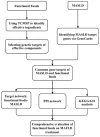Biomarkers for Health Functional Foods in Metabolic Dysfunction-Associated Steatotic Liver Disorder (MASLD) Prevention: An Integrative Analysis of Network Pharmacology, Gut Microbiota, and Multi-Omics
- PMID: 39339660
- PMCID: PMC11434757
- DOI: 10.3390/nu16183061
Biomarkers for Health Functional Foods in Metabolic Dysfunction-Associated Steatotic Liver Disorder (MASLD) Prevention: An Integrative Analysis of Network Pharmacology, Gut Microbiota, and Multi-Omics
Abstract
Metabolic dysfunction-associated steatotic liver disorder (MASLD) is increasingly prevalent globally, highlighting the need for preventive strategies and early interventions. This comprehensive review explores the potential of health functional foods (HFFs) to maintain healthy liver function and prevent MASLD through an integrative analysis of network pharmacology, gut microbiota, and multi-omics approaches. We first examined the biomarkers associated with MASLD, emphasizing the complex interplay of genetic, environmental, and lifestyle factors. We then applied network pharmacology to identify food components with potential beneficial effects on liver health and metabolic function, elucidating their action mechanisms. This review identifies and evaluates strategies for halting or reversing the development of steatotic liver disease in the early stages, as well as biomarkers that can evaluate the success or failure of such strategies. The crucial role of the gut microbiota and its metabolites for MASLD prevention and metabolic homeostasis is discussed. We also cover state-of-the-art omics approaches, including transcriptomics, metabolomics, and integrated multi-omics analyses, in research on preventing MASLD. These advanced technologies provide deeper insights into physiological mechanisms and potential biomarkers for HFF development. The review concludes by proposing an integrated approach for developing HFFs targeting MASLD prevention, considering the Korean regulatory framework. We outline future research directions that bridge the gap between basic science and practical applications in health functional food development. This narrative review provides a foundation for researchers and food industry professionals interested in developing HFFs to support liver health. Emphasis is placed on maintaining metabolic balance and focusing on prevention and early-stage intervention strategies.
Keywords: HFFs; gut microbiota; metabolic dysfunction-associated steatotic liver disease; omics approach.
Conflict of interest statement
The authors declare no conflicts of interest.
Figures



Similar articles
-
Unraveling Metabolic Dysfunction-Associated Steatotic Liver Disease Through the Use of Omics Technologies.Int J Mol Sci. 2025 Feb 13;26(4):1589. doi: 10.3390/ijms26041589. Int J Mol Sci. 2025. PMID: 40004054 Free PMC article. Review.
-
Multi-omics analyses of the gut microbiota and metabolites in children with metabolic dysfunction-associated steatotic liver disease.mSystems. 2025 Apr 22;10(4):e0114824. doi: 10.1128/msystems.01148-24. Epub 2025 Mar 14. mSystems. 2025. PMID: 40084870 Free PMC article.
-
A Systems Biology Approach to Memory Health: Integrating Network Pharmacology, Gut Microbiota, and Multi-Omics for Health Functional Foods.Int J Mol Sci. 2025 Jul 12;26(14):6698. doi: 10.3390/ijms26146698. Int J Mol Sci. 2025. PMID: 40724948 Free PMC article. Review.
-
Exploring the Regulatory Effect of LPJZ-658 on Copper Deficiency Combined with Sugar-Induced MASLD in Middle-Aged Mice Based on Multi-Omics Analysis.Nutrients. 2024 Jun 25;16(13):2010. doi: 10.3390/nu16132010. Nutrients. 2024. PMID: 38999758 Free PMC article.
-
Dietary Influences on Gut Microbiota and Their Role in Metabolic Dysfunction-Associated Steatotic Liver Disease (MASLD).Nutrients. 2024 Dec 31;17(1):143. doi: 10.3390/nu17010143. Nutrients. 2024. PMID: 39796579 Free PMC article. Review.
Cited by
-
Pollutants in Microenvironmental Cellular Interactions During Liver Inflammation Cancer Transition and the Application of Multi-Omics Analysis.Toxics. 2025 Feb 25;13(3):163. doi: 10.3390/toxics13030163. Toxics. 2025. PMID: 40137490 Free PMC article. Review.
-
Unraveling Metabolic Dysfunction-Associated Steatotic Liver Disease Through the Use of Omics Technologies.Int J Mol Sci. 2025 Feb 13;26(4):1589. doi: 10.3390/ijms26041589. Int J Mol Sci. 2025. PMID: 40004054 Free PMC article. Review.
-
Special Issue: "Gut Microbiota and Nutrition in Human Health".Int J Mol Sci. 2024 Oct 29;25(21):11589. doi: 10.3390/ijms252111589. Int J Mol Sci. 2024. PMID: 39519138 Free PMC article.
-
Editorial: Precision nutrition and nutrients: making the promise a reality.Front Nutr. 2025 Jan 27;12:1553149. doi: 10.3389/fnut.2025.1553149. eCollection 2025. Front Nutr. 2025. PMID: 39931364 Free PMC article. No abstract available.
-
Lipids dysregulation in diseases: core concepts, targets and treatment strategies.Lipids Health Dis. 2025 Feb 21;24(1):61. doi: 10.1186/s12944-024-02425-1. Lipids Health Dis. 2025. PMID: 39984909 Free PMC article. Review.
References
-
- Eslam M., Sarin S.K., Wong V.W.-S., Fan J.-G., Kawaguchi T., Ahn S.H., Zheng M.-H., Shiha G., Yilmaz Y., Gani R., et al. The Asian Pacific Association for the Study of the Liver clinical practice guidelines for the diagnosis and management of metabolic associated fatty liver disease. Hepatol. Int. 2020;14:889–919. doi: 10.1007/s12072-020-10094-2. - DOI - PubMed
-
- Dong X., Li J.-M., Lu X.-L., Lin X.-Y., Hong M.-Z., Weng S., Pan J.-S. Global burden of adult non-alcoholic fatty liver disease (NAFLD) and non-alcoholic steatohepatitis (NASH) has been steadily increasing over the past decades and is expected to persist in the future. Transl. Gastroenterol. Hepatol. 2024;9:33. doi: 10.21037/tgh-23-118. - DOI - PMC - PubMed
Publication types
MeSH terms
Substances
Grants and funding
LinkOut - more resources
Full Text Sources
Miscellaneous

